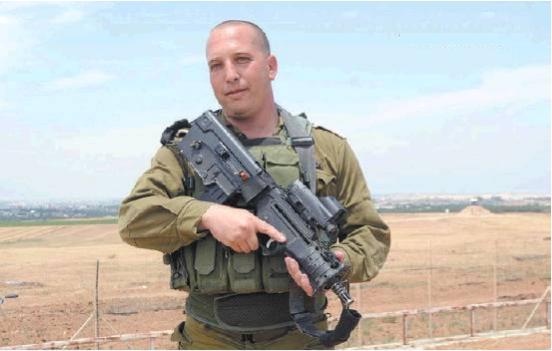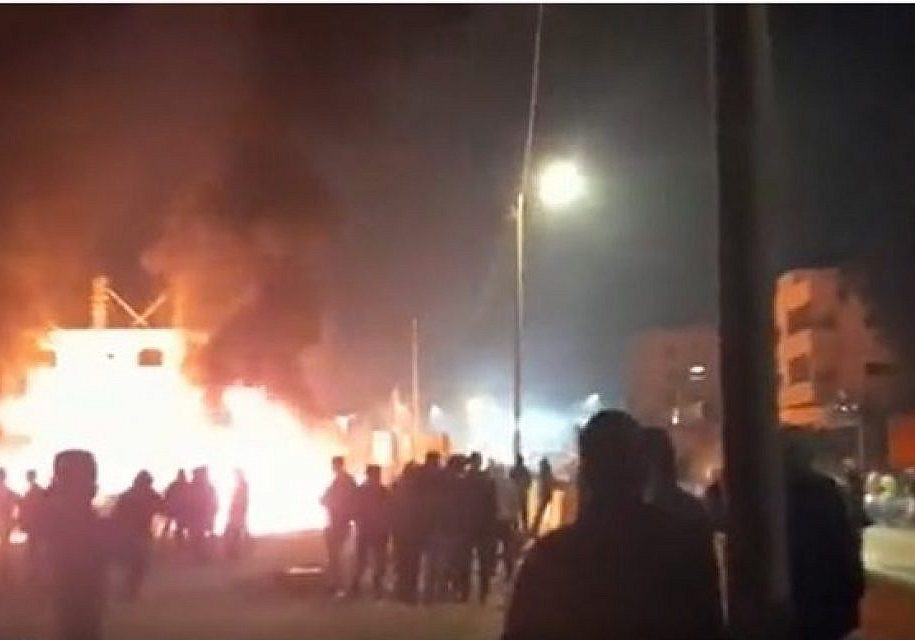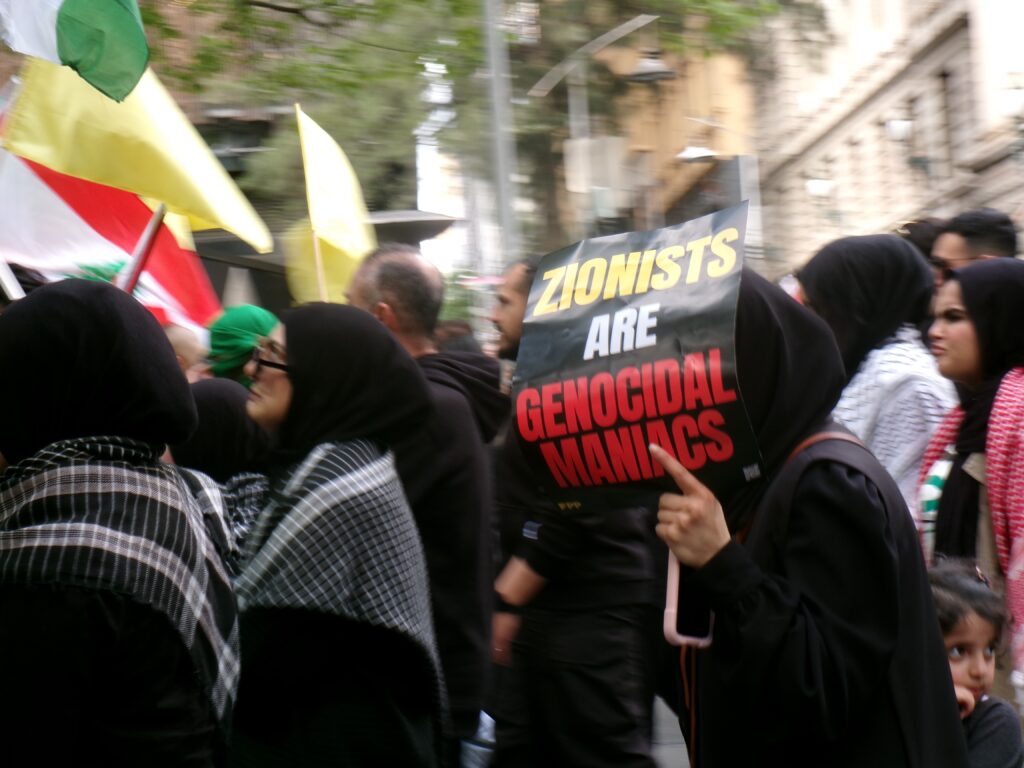FRESH AIR
IDF commander: ‘Hamas is exploiting our morality’
May 18, 2018 | Ahron Shapiro

Today’s Israel Hayom newspaper includes a feature-length article based on an interview with Lt. Col. Sivan Bloch, a battalion commander in the Golani Brigade stationed on the Gaza border. While that article is in Hebrew, AIJAC has translated the article for the benefit of people who do not know Hebrew.
The link to the original article in Hebrew is here.
The article from the newspaper, which is supported by advertisements in Israel and distributed at no cost to the consumer, follows in full below.
Headline: “We are the moral army in the world and Hamas is exploiting it”
The riots in the Gaza Strip reached a peak this week, when more than 60 Palestinians were killed on Monday, most of them terrorists. Lt. Col. Sivan Bloch, a battalion commander in the Golani Brigade, describes the complex task and the reality that is reminiscent of a war field in every respect. • “These are not people who came to make peace, when the crowd runs to you with knives and axes – you understand that if this does not stop here, they will be able to cross the fence to an Israeli settlement”
Nicky Gutman, Israel Hayom, 18.5.2018
The last two months were possibly among the most tense in the area of the Gaza Strip. The threats from the Palestinian side began before the Passover seder. The violence broke out, but it was clear that Hamas would crank things up a notch in response to the moving of the American embassy to Jerusalem. In addition to the attempts – which finally succeeded – to bring tens of thousands of demonstrators to the fence to challenge the IDF, a Hamas terrorist attack tunnel that penetrated Israeli territory in Jabaliya was thwarted, and last Saturday another tunnel was cleared in the Erez crossing. Lt. Col. Sivan Bloch, commander of the 12th battalion of the Golani Brigade, along with his comrades, is spending the eighth straight Sabbath in the sector, and knows that this is an unusual period.
We accompanied Lt. Col. Bloch this week to a tour of the northern brigade in Gaza after the difficult day in which more than 60 Palestinians were killed (at least 50 of them terrorists). Although Hamas has made a decision to turn down the flames slightly, no one is lowering their guard. “We began the operational preparations for organized disturbances before the Seder,” he says. “This is an intensive period in which the operational tension of the fighters is very high.
“People think that disturbances are only taking place on Fridays, but since the Seder night, the soldiers have been sitting here every morning until evening, and there are amazing fighters here, and Hamas also organizes a lot of hostile terrorist activity – here is where someone came with a Kalashnikov, there is where a terrorist tried to lay an explosive charge, but despite everything they did not succeed in breaching the fence.”
Bloch points to a spot near the fence, where the last terror tunnel, discovered a few meters from Israeli territory, was located and neutralized. “It’s clear where they planned to go with the tunnel, right behind us we see the avocado plantation of Kibbutz Erez,” he says. As we speak, Hamas members are observing their positions. Bloch: “These positions are scattered all the way, Hamas is not keeping quiet, but is working and watching now and is asking itself what we are doing here”. Hamas is watching from agricultural fields among being worked by Gazan farmers, and Israel has every reason to allow the farmers to continue to do so, even under sensitive conditions. “We want the farmers to work without interruption, but it is also a very big challenge for us – to identify whether these eight [workers in the field] are really farmers and working their land for the sake of livelihood, or is it camouflage for people who come to carry out terrorist attacks”, explains Bloch, pointing to a building in the field: “On Land Day, precisely from there, three people who came up to here, entered [the border zone], crossed the fence, cut it and tried to steal our equipment.”
Beyond the difficult and complex fighting and the danger posed to the fighters, they are forced to cope with the harsh scenes of children and women exploited by Hamas. “I find it hard to see a 9-year-old boy coming to the fence with his mother, and together they are trying to throw stones at me,” says Bloch. Bloch pulls out his cell phone and shows me pictures he took of the fence, showing women and children sent to the front line: “It does not seem reasonable for me to send 14 or 15-year-old girls. How old is this boy, 10? They know that we are Israelis, the most moral army in the world, and they take advantage of it. On Land Day, we saw the girl they sent over the fence, and the IDF brought her back … Hamas is weak and cowardly and uses civilians because it does not succeed with us by other means.” Bloch adds that conversations with soldiers who deal with these difficult images are very important: “I had a talk with each company – it’s already become routine – but I think we need to renew and refresh each time so we can continue the mission.”
Thousands are waiting on the hills
The reality the soldiers live in is everywhere, and it resembles a battleground for everything: the artificial hill set up near the fence to serve the snipers, the “tigers” [armoured vehicles], and the tanks deployed throughout the day, bags of soldier’s gear and camouflaged posts, scorched earth from fire and smoke. “Up here, a sniper will be able to control the height in the most precise way, so that the bullet will not accidentally hit something and be deflected sideways. This is a difficult and challenging task when masses of rioters with knives and axes try to cut the fence”, explains Bloch.
At the height of the events, last Monday, 40,000 demonstrators arrived at 13 locations along the fence. “Hundreds of people approach the fence, everything is black and dark and you can not see anything, you do not see the fence, you get hit by Molotov cocktails, explosive charges, stones flying at the soldiers. People cut the fence, coming with axes, wire cutters and disks, and you hear Hamas shots through the murky haze and see the them pushing forward, and you have to stop them. The soldiers understand that if they break in, there will be a disaster,” says Bloch, pointing to the city of Sderot and nearby Kibbutz Nir Am.
There have been many criticisms of the IDF’s firing policy, especially in light of the high number of fatalities, but Bloch explains that shooting is the last choice – even in the face of the harsh conditions he described: “Here soldiers stand with crazy restraint, who understand the big picture and do everything possible not to hurt others. They take calculated risks, and when there is no other choice, they target accurately. We try to hurt those we understand to be the main instigators, but that too was only after I let them know first – after I fired in the air and warned them.”
“These are not people who came to make peace. When the crowd runs to you with knives and axes – you have no choice and you understand that if it does not stop here, they will cross the fence and reach an Israeli settlement. They know it’s the last line, twenty or thirty people who break out will bring more. You see thousands on the hills just waiting for it.”
Despite the fact that the disturbances are not foreign to Blauch, who has been on the front line with the battalion for six months, he explains that this is a more complex situation: “It’s a game you do not manage in any way. On the one hand, one must maintain a very high operational tension, while on the other hand, know when to let the soldiers refresh, change uniforms and take a shower. You constantly analyze the enemy, constantly have to make situation assessments with yourself. I prepare myself for all the scenarios, and especially for the hostile terrorist activity, and we are also ready to disrupt the arrangement at the same time, the friction is daily and challenging – and thought-provoking.”
So that the people can celebrate
In keeping with the spirit of the IDF, Bloch was in the area with the soldiers and lived close to everything.
“The senior command is situated on the front,” he says. “If you took a picture of me on Monday, I would have been black from the soot of the tires. The people of Israel should be proud of our fighters. There are close-knit fighters from all the units, and sometimes it is frustrating that it is difficult to convey the reality out to the public at home. I believe in the justice of the way, trusting my fighters and very proud of them.”
A new threat in the sector, which has recently caught the headlines, are the incendiary kites that the Palestinians launch and cause fires on the Israeli side. “It is kind of funny and sad at the same time,” Bloch says. “The great Hamas, which talks about tunnels and declared that it will cross the fence with hundreds of thousands of people, at the end of the day, just flies a kite. True, it burns our fields and damages agriculture, but that is not what will break us. We handle it. The number of kites that were in the air in comparison to those landing in Israel indicates the effectiveness of the IDF’s handling of this issue.”
The tour we went out on was on Wednesday afternoon, and a few hours later, bullets fired from a heavy machine gun from the Gaza Strip hit a number of houses in Sderot and a vehicle belonging to a resident of the Sdot Negev Regional Council. “The whole process of terrorist activity is continuing,” said Bloch’s battalion commander, “The process by which Hamas wants to enter Israeli territory is not over, but there has been relative quiet in the past month in terms of mortar fire, apparently because Hamas did not want to destroy the image of the ‘civilian demonstration’ near the fence.” Asked if he believed the fire would resume, Bloch replies: “It will not surprise me at all, but Hamas will regret that day.”
The knowledge that they are protecting the Israeli settlements gives the fighters and the commanders motivation, but of course this does not contradict the homesickness. On the question of “How much time has passed since you were last home”, one of the company commanders we meet on the ground answers with a smile: “We’ve stopped counting.” Bloch says that “this is the hardest part – that we do not see the wife or children. It’s essentially not easy on families.
“At the end of the day, the American Embassy moved to Jerusalem, I sat with all the company commanders and my staff in conclusion and told them: ‘I am very proud of you for the mission and the camaraderie. Look at what a great honor [there is in Jerusalem] – people with ties drinking champagne and to my delight, they pass the day in the most beautiful and dignified way, and in the evening thousands celebrate in Rabin Square the winning of the Eurovision Song Contest, thanks to everyone sitting here.’ This is the essence of our mission.”
“It is important to explain again and again that a small thing that you are supposed to do here, and any sniper, fighter or company commander who spends their Shabbat here, all of these allow citizens to celebrate freely. For the sake of this, I’m here.”
Tags: Hamas
RELATED ARTICLES

‘Time’s up for talk’: Joel Burnie discusses Antisemitism Envoy’s report on Sky News

‘Optimism’ for Hamas to ‘exile’ their power and create a permanent ceasefire with Israel: Joel Burnie on Sky News

Australian government’s response to Iran-Israel conflict ‘disappointing’: Paul Rubenstein on Sky News




















